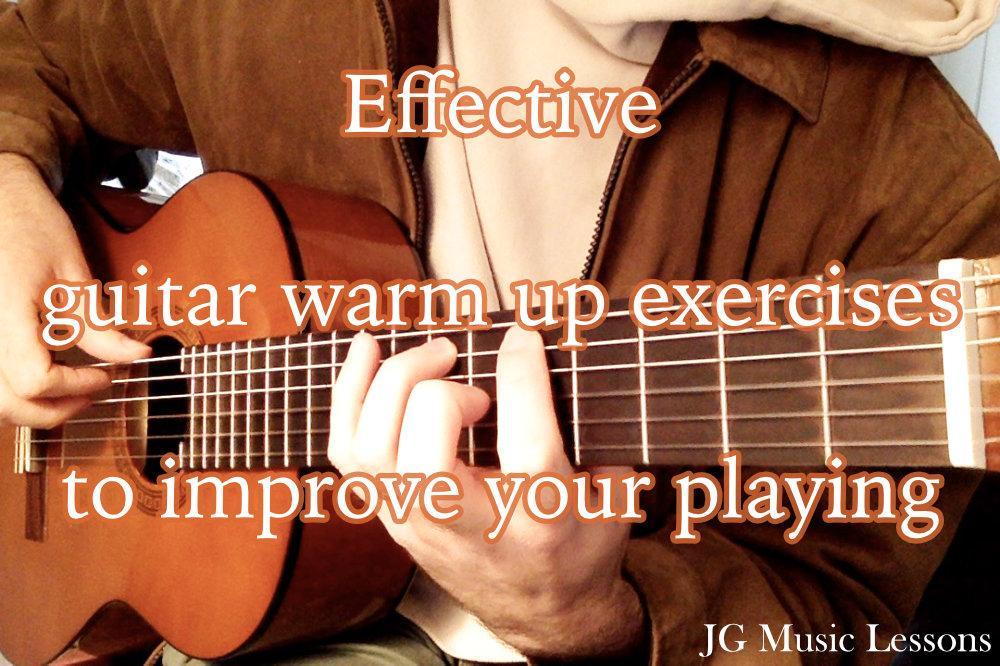Whether you’re a beginner or have been playing for several years, guitar warmups can help you develop and maintain good technique on your instrument as well as challenge you to work out different music theory concepts as a part of your practice routine.
This lesson covers several ideas for warm up exercises at various skill levels. They don’t have to be followed in order but are written from easier to more complex musical concepts.
These examples can be played regardless of whether you play with a pick or use your fingers, as well as the type of guitar you use (acoustic, classical, or electric guitar).
If you do want further detail on how to play or improve using your fingers, check out this other lesson on how to finger pick on guitar (including exercises).
Technical exercises for coordination
These first couple of technical exercises are especially helpful for beginners. Even though these guitar finger exercises aren’t scales, they will help you to coordinate your left and right hand.
Using a metronome or backing tracking track is recommended to help you keep good time. Here is a free metronome on our site.
These exercises start as easy guitar warm ups and gradually increase in difficulty. If some of them start to feel like too wide of a stretch for your fingers, you can always play them higher up on the fretboard. This is because the frets are smaller as you go higher up, making it easier on your fingers.
Here is what each number represents on the fretting hand:
1 = pointer finger
2 = middle finger
3 = ring finger
4 = pinky
Here are some examples of these exercises that you would play on each string. You can play them anywhere on the fretboard, but I’m starting them on the 5th fret.
1, 2 picking pattern

1, 3 picking pattern

1, 2, 3 picking pattern

1, 4 picking pattern

1, 2, 3, 4 picking pattern

You can also try different variations of these exercises such as:
- 1, 3, 2, 4
- 1, 4, 2, 3
You can play any of these examples in reverse as well. For example, instead of 1, 2, 3, you can do 3, 2, 1 across each string instead.
Also experiment and try coming up with your own variations for warm up exercises.
Wider finger stretching exercises
Similar to the previous examples, the following are more examples of technical exercises to be able to stretch your fingers more widely on the fretboard.
Again, if these finger stretches seem too difficult, play them higher up on the fretboard or come back to them as you learn to build more strength.
1, skip, 2, skip, 4 picking pattern
*Skip refers to skipping a fret between fingerings as you’ll see in the example below.

1, skip, 2, 3, 4 picking pattern

Even though these exercises help to develop your fretting technique, as soon as you can, I would start focusing more on learning scales which will already include a variety of these technical exercises.
Warm up scales
After learning some of the technique building exercises, you can start to learn scales. I recommend learning to play all Major scales across the fretboard which also covers the natural minor scale by starting on different notes.
Afterward, I would learn the melodic and harmonic minor scales which I cover in this other lesson, how to improvise on guitar.
If you don’t know how to play a Major scale, check out this lesson on learning the 5 Major scale shapes you need to know. This is crucial to know because any scale can be several different ways on the guitar.
Here is an example of the C Major scale in one position starting on the 6th string.
Major scale example

Natural minor scale example
Now, here is the C minor scale in one position starting on the 6th string.

Melodic minor scale example

Harmonic minor scale example

I would practice these scales in all keys so you can master playing them over any song or chord progression. You can also check this lesson for more on how to play minor scales on guitar.
Practicing Scale Intervals
Playing intervals means you’re skipping a certain distance between notes in a scale. Practicing intervals helps you to work out different sounds that come from a scale and can give you different ideas for melodies and improvisation.
These examples are in C Major but you can apply this same concept to natural minor scales, melodic minor, harmonic minor, or other scales you’re working on.
Here are some ideas of different intervals you can use to practice a scale.
C Major scale using intervals of 3rds

C Major scale using intervals of 4ths

C Major scale using intervals of 5ths
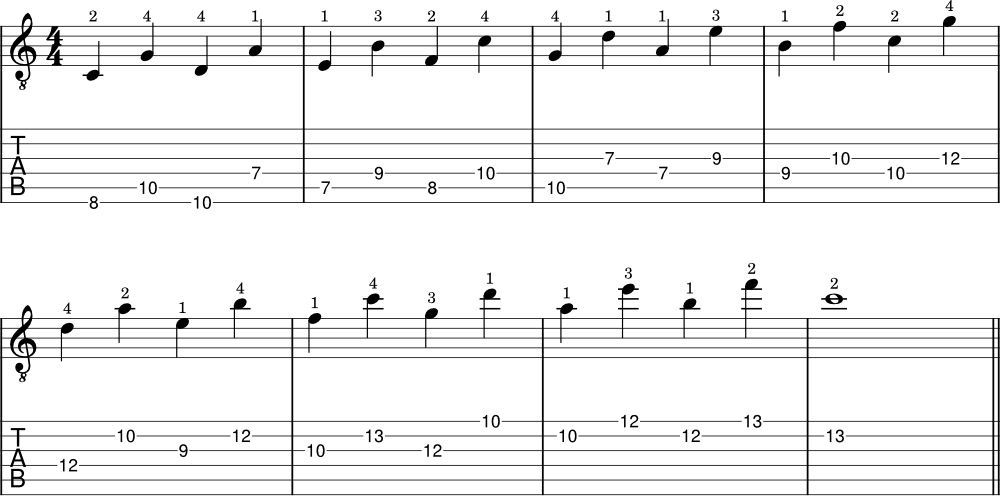
C Major scale using intervals of 6ths

C Major scale using intervals of 7ths
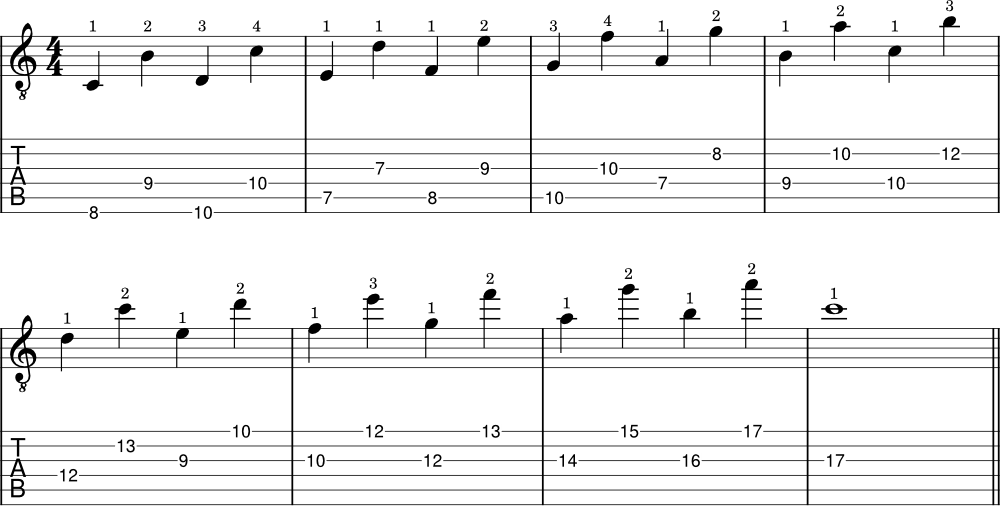
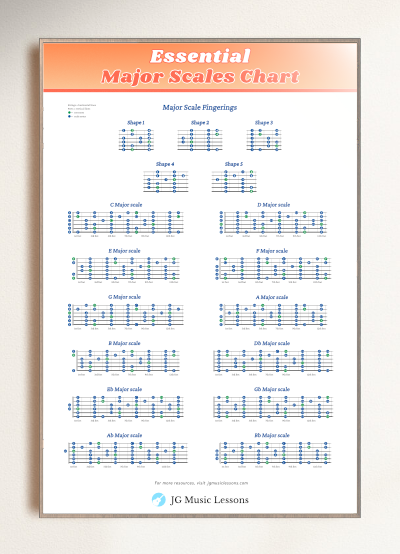
Other ways to practice scale intervals
For all of these exercises, you can also play them in reverse with the same fingerings as well in descending order for each scale note.
For example, in thirds, the reverse order for each scale note would be:
C, E, then, B, D, then, A, C, etc…
In descending order for each scale note would be:
E, C, then, F, D, then, G, B, etc…
You can also play them in alternating sequences between ascending and descending order. For example, ascending to descending order would be:
C, E (asc) then, F, D (desc), then E, G (asc), etc…
And also descending to ascending order would be:
E, C (desc) then, D, F (asc), then G, E (desc), etc…
Again, this is just one Major scale we’re covering here but I recommend playing in different keys for your warming up during practice.
Triad warm up exercises
You can play these in one position of the fretboard or all also across the fretboard like in these examples. You can think of these exercises as arpeggios of triad chords. Check out this lesson to learn the Major triad shapes on guitar.
C Major triad example

C minor triad example

C diminished triad example

Diatonic chord triads
This simply means all the triads that naturally derive on each of the scale notes within a Major scale.
For example, the diatonic chords in C Major are,
- C Major triad
- D minor triad
- E minor triad
- F Major triad
- G Major triad
- A minor triad
- B diminished triad
Check out this other post to learn the related chords for all Major and minor keys.
Ascending diatonic triads
Here is an example of playing diatonic triads in the key of C Major in one position of the fretboard.

Descending diatonic triads
You can practice this diatonic triad exercise in various ways. For example, you could play each triad in descending order (5, 3, 1 instead of 1, 3, and 5) Like this:

Alternating ascending and descending triads
Another way to practice diatonic triads is by alternating the direction of each triad by playing one ascending and the next in descending order like this:
Ascending/Descending pattern:
C, E, G (asc), then A, F, D (desc), then E, G, B (asc), etc…
Descending/Ascending pattern:
G, E, C (desc) then D, F, A (asc), them B, G, E (desc), etc…
Triads through the circle of 5ths
Another way we can practice triads is to take the chords through all the keys using the circle of 5ths.
If you don’t know what the circle of 5ths is, it’s a chart that shows all of the available Major and relative minor keys separated by the distance of a 5th in a clockwise manner. This is the order of the 12 Major keys starting on C:
C, G, D, A, E, B, Gb, Db, Ab, Eb, Bb, and F.
We can use each of these root notes in the circle of 5ths as our framework to practice triads.
These warm up exercises using the circle of 5ths were inspired by a video from guitarist Ben Eunson. You can check out his site at beneunson.com
Major triads using the circle of 5ths

Minor triads using the circle of 5ths
This follows all the root notes of the circle of 5ths but now we’re making every chord minor: C minor, F minor, Bb minor, Eb minor, etc… See this lesson on minor triad shapes on guitar if needed.

Diminished triads using the circle of 5ths
Here also, we’re changing every chord quality to diminished while going through the circle of 5ths: C diminished, F, diminished, Bb diminished, Eb diminished, etc…
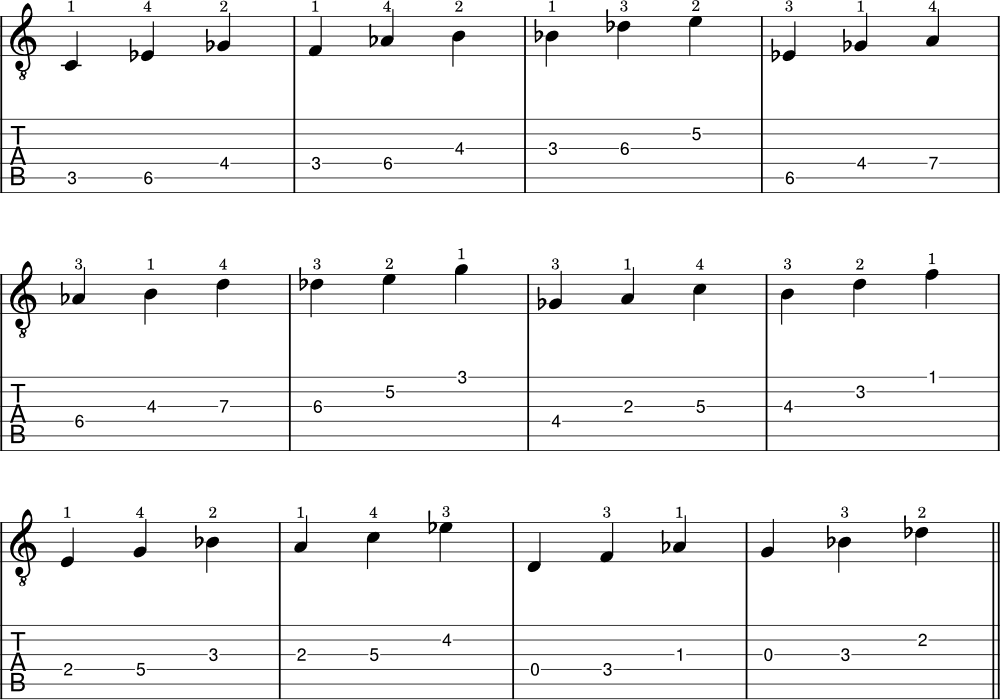
These are just one way you can play these exercises. Feel free to explore different fingerings and areas of the fretboard to practice this.
Wrapping up
Guitar warm up exercises are beneficial at any point of your learning journey and there are many ways to challenge and develop your skills as a part of your practice routine. As you develop your technique, it’s beneficial to also try to apply new music theory concepts you’re learning.
I personally like to write down what I’m working on during practice time to remember where I left off and where to pick up again next time. You can also do so with this practice guide to help you keep track of your practice material.
I hope you found this material helpful and gave you some good ideas for warming up on your instrument.
For other insights related to scales, check out how to practice scales on guitar.
📘 Get the free guitar practice guide here!
All the best,
JG Music Lessons
Start Playing Better, Faster
by becoming a Pro Member! ✨
Transform your playing by enjoying benefits such as:
• 📙 Exclusive Lesson PDFs and Ebooks
Get access to a growing library of clear, downloadable resources—save time and skip the clutter.
• 🎼 Full Song Lessons
Break down your favorite songs step by step, and play them with confidence.
• 🚫 Ad-Free Learning
Focus better with a distraction-free environment.
• 🎁 Store Discounts
Save 50% off on all song PDFs, charts, audio tracks, bundles, and design printables.
• 💬 Member Support
Got questions? We’ve got your back, helping you stay on track!
👉 Join Here!
Level up with the FREE guitar practice guide and effectively improve your playing! 🎸
Get it sent to your email!

